
Jay Ginn and
Sara Arber (2002) 'Degrees of Freedom: Do Graduate
Women escape the Motherhood Gap in Pensions?'
Sociological Research Online, vol. 7, no. 2,
<http://www.socresonline.org.uk/7/2/ginn.html>
To cite articles published in Sociological Research Online, please reference the above information and include paragraph numbers if necessary
Received: 7/2/2002 Accepted: 31/8/2002 Published: 31/8/2002
 Abstract
Abstract Introduction
Introduction Mothers' Employment And Educational
Level
Mothers' Employment And Educational
Level
 Pension implications of low earnings
and part time employment
Pension implications of low earnings
and part time employment
 Aims and Methods
Aims and Methods
 Lifecourse Stage and Women's
Employment
Lifecourse Stage and Women's
Employment
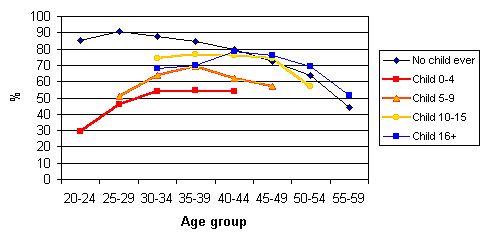
|
| Figure 1a Percentage of women employed by maternal status and age group |
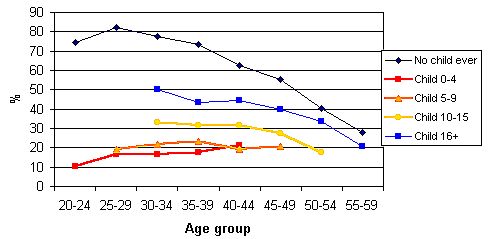
|
| Figure 1b Percentage of women employed full time by maternal status and age group |
| (a) % employed | (b) % employed full time | |||||||||
| Degree+ | A levels | O/GCSE | Other | None | Degree+ | A levels | O/GCSE | Other | None | |
| Lifecourse | ||||||||||
| Category: | ||||||||||
| All women | 81 | 76 | 72 | 65 | 53 | 55 | 50 | 39 | 33 | 22 |
| Nev child, <35 | 92 | 91 | 90 | 81 | 63 | 84 | 82 | 79 | 69 | 52 |
| Child 0-4 | 70 | 54 | 51 | 42 | 26 | 29 | 21 | 15 | 12 | 6 |
| Child 5-9 | 81 | 72 | 69 | 58 | 43 | 40 | 21 | 19 | 21 | 10 |
| Child 10-15 | 87 | 84 | 78 | 77 | 63 | 47 | 33 | 30 | 29 | 20 |
| Child 16+ | 75 | 76 | 76 | 74 | 58 | 46 | 47 | 40 | 37 | 25 |
| Nev child, 35+ | 81 | 81 | 83 | 67 | 57 | 69 | 71 | 63 | 51 | 37 |
| Cramer's V | 0.21 | 0.33 | 0.31 | 0.30 | 0.24 | 0.41 | 0.54 | 0.49 | 0.37 | 0.24 |
| Under age 35: | ||||||||||
| Never child | 92 | 91 | 90 | 81 | 63 | 84 | 82 | 79 | 69 | 52 |
| Child 0-4 | 69 | 53 | 50 | 40 | 25 | 31 | 21 | 15 | 10 | 5 |
| Phi | 030 | 0.44 | 0.44 | 0.40 | 0.34 | 0.52 | 0.60 | 0.65 | 0.62 | 0.53 |
p<.001 at each educational level
* Full time employment is defined
as 31+ hours per week usually worked
Full time students excluded from the analysis
For base numbers see Appendix 1
Source: General Household Surveys 1994-6 (authors' analysis)
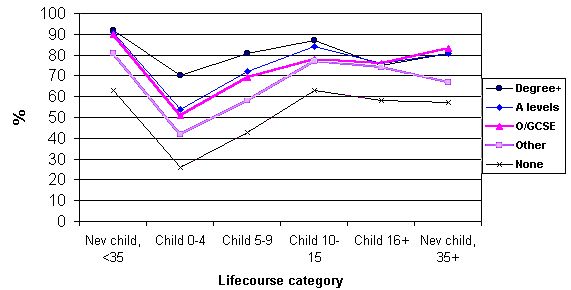 |
| Figure 2a Percentage of women employed by life course category and educational level |
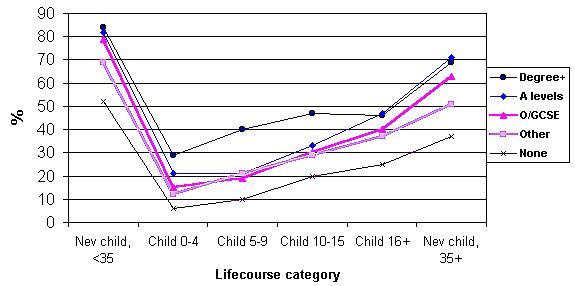
|
| Figure 2b Percentage of women employed by life course stage and educational level |
 Lifecourse Stage and Women's Earnings
Lifecourse Stage and Women's Earnings
| Degree+ | A levels | O/GCSE | Other | None | All | |||
| Lifecourse | ||||||||
| Category: | ||||||||
| All women | £220 | 131 | 85 | 60 | 14 | 77 | ||
| Nev child, <35 | 272 | 191 | 179 | 156 | 92 | 196 | ||
| Child 0-4 | 120 | 15 | 0 | 0 | 0 | 0 | ||
| Child 5-9 | 150 | 75 | 49 | 29 | 0 | 42 | ||
| Child 10-15 | 231 | 115 | 88 | 71 | 40 | 80 | ||
| Child 16+ | 191 | 134 | 100 | 91 | 35 | 69 | ||
| Nev child, 35+ | 300 | 215 | 192 | 129 | 53 | 162 |
*Full time students excluded from the
analysis
Source: General Household Surveys 1994-6 (authors' analysis)
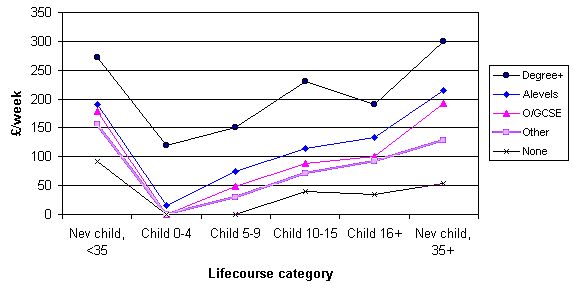
|
| Figure 3 Median earnings by life course category and educational level |
 Private pension coverage
Private pension coverage
| a) All adults | b) Employees | ||||||||||
| All | Men | Women | All | Men | Women | ||||||
| All | FT* | PT | |||||||||
| Has private pension: | 51 | 64 | 38 | 68 | 80 | 56 | 71 | 37 | |||
| Employee, occupational pension | 33 | 40 | 27 | 51 | 59 | 42 | 55 | 26 | |||
| Employee, personal pension | 12 | 15 | 9 | 17 | 21 | 14 | 16 | 11 | |||
| Self-empld, personal pension | 5 | 9 | 2 | ||||||||
| No private pension: | 49 | 36 | 62 | 32 | 20 | 44 | 29 | 63 | |||
| Employee | 21 | 14 | 27 | ||||||||
| Self-employed | 5 | 6 | 3 | ||||||||
| Not employed | 23 | 16 | 31 | ||||||||
| Col % | 100 | 100 | 100 | 100 | 100 | 100 | 100 | 100 | |||
| N= | 34855 | 16817 | 18038 | 22663 | 11403 | 11260 | 6325 | 4935 |
* Full time employment defined as 31+ hours per week usually worked
Full time students excluded from the analysis
Source: General Household Surveys 1994-6 (authors' analysis)
| a) Educational attainment: | ||||||||||
| 1. Degree/equivalent and above | 88 | 76 | 84 | 57 | ||||||
| 2. A level/equivalent | 81 | 61 | 68 | 45 | ||||||
| 3. O level/GCSE | 79 | 57 | 72 | 39 | ||||||
| 4. Other qualifications | 75 | 50 | 65 | 34 | ||||||
| 5. No qualifications | 73 | 39 | 59 | 26 | ||||||
| N | 9986 | 10746 | 5937 | 4809 | ||||||
| b) Socioeconomic category (SEC): | ||||||||||
| 1. Professionals/managers in large organisations | 93 | 84 | 86 | 71 | ||||||
| 2. Intermed non-manual/managers in small orgs | 84 | 72 | 79 | 57 | ||||||
| 3. Routine non-manual | 79 | 54 | 70 | 38 | ||||||
| 4. Skilled manual | 77 | 52 | 61 | 34 | ||||||
| 5. Semi-skilled manual | 66 | 37 | 51 | 26 | ||||||
| 6. Unskilled manual | 54 | 21 | 42 | 18 | ||||||
| N | 11383 | 11254 | 6322 | 4932 |
* Full time
employment defined as 31+ hours per week usually worked
Full time students excluded from the analysis
Base numbers for education and SEC differ because of missing data on educational qualifications;
among women employees 518 had missing data for educational qualifications
Source: General Household Surveys 1994-6 (authors' analysis)
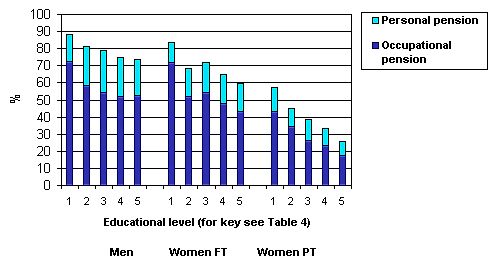
|
| Figure 4a Percentage of employees contributing to a private pension by education level, gender and hours of work |
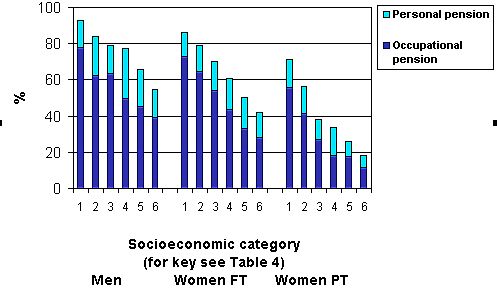
|
| Figure 4b Percentage contributing to a private pension by socioeconomic category, gender and hours of work |
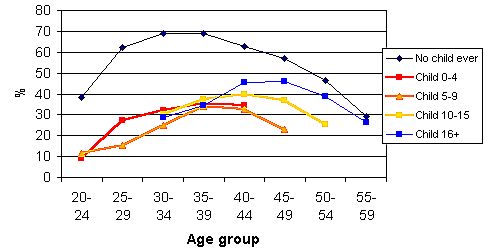
|
| Figure 5 Percentage of women contributing to a private pension by maternal status and age group |
| Lifecourse | Degree+ | A levels | O/GCSE | Other | None | ||||
| Category: | |||||||||
| All women | 61 | 48 | 41 | 34 | 22 | ||||
| Never child, <35 | 65 | 54 | 58 | 39 | 26 | ||||
| Child 0-4 | 55 | 38 | 28 | 22 | 7 | ||||
| Child 5-9 | 54 | 38 | 26 | 23 | 10 | ||||
| Child 10-15 | 62 | 46 | 41 | 35 | 19 | ||||
| Child 16+ | 60 | 48 | 45 | 40 | 27 | ||||
| Never child, 35+ | 72 | 70 | 63 | 51 | 35 | ||||
| Cramer's V | 0.11 | 0.18 | 0.27 | 0.20 | 0.21 | ||||
| Under age 35: | |||||||||
| Never child | 65 | 54 | 58 | 39 | 26 | ||||
| Child 0-4 | 54 | 37 | 27 | 19 | 6 | ||||
| Phi | 0.11 | 0.16 | 0.32 | 0.22 | 0.28 |
p<.001 at each educational level
Full time students excluded from the analysis
Source: General Household Surveys 1994-6 (authors' analysis)
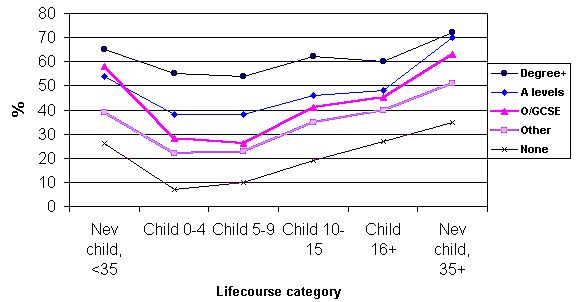
|
| Figure 6 Percentage of women contributing to a private pension by lifecourse stage and educational level |
 Summary and Conclusions
Summary and Conclusions
 Appendix
AppendixClick here for Excel file of Figures shown above
Appendix 1: Base numbers of women by lifecourse category and
educational qualifications
| Degree+ | A levels | O/GCSE | Other | None | All | % in each lifecourse category | |||
| Lifecourse Category: | |||||||||
| Never child, <35 | 831 | 586 | 921 | 294 | 171 | 2803 | 16% | ||
| Youngest child 0-4 | 624 | 403 | 1204 | 547 | 687 | 3465 | 20% | ||
| Youngest child 5-9 | 375 | 224 | 659 | 354 | 557 | 2169 | 13% | ||
| Youngest child 10-15 | 363 | 154 | 565 | 324 | 742 | 2148 | 13% | ||
| Youngest child 16+ | 650 | 253 | 1011 | 733 | 2479 | 5126 | 30% | ||
| Never child, 35+ | 371 | 117 | 339 | 196 | 399 | 1422 | 8% | ||
| All aged 20-59 | 3214 | 1737 | 4699 | 2448 | 5035 | 17133 | 100% | ||
| % in each qualifications group | 19% | 10% | 27% | 14% | 29% | 100% | |||
| All aged <35 | 1303 | 1021 | 2321 | 954 | 988 | 6587 | |||
| % in each qualifications group | 20% | 16% | 35% | 14% | 15% | 100% |
Source: General Household Surveys 1994-6 (authors' analysis)
| % employed | % employed FT | N | ||||||||
| GHS | BHPS | GHS | BHPS" | BHPS* | GHS | BHPS | ||||
| Never child <35 | 92 | 96 | 84 | 92 | 81 | 831 | 89 | |||
| Youngest ch 0-4 | 70 | 68 | 29 | 40 | 31 | 624 | 57 | |||
| Youngest ch 5-9 | 81 | 81 | 40 | 62 | 46 | 375 | 21 | |||
| Youngest ch 10-15 | 87 | 85 | 47 | 67 | 52 | 363 | 27 | |||
| Youngest ch 16+ | 75 | 90 | 46 | 69 | 57 | 650 | 29 | |||
| Never child 35+ | 81 | 84 | 69 | 83 | 69 | 371 | 30 | |||
| All graduate women | 81 | 86 | 55 | 72 | 57 | 3214 | 253 |
" FT defined as 30+ hours per week
* FT defined as 31+ hours per week
Sources: BHPS 1994; GHS 1994-6
Thanks are due to Dr Kim Perren for the analysis of the 1994 BHPS used here
![]()
 Acknowledgements
Acknowledgements
BRANNEN, J., MESZAROS, G., MOSS, P. and POLAND, G. (1994) Employment and Family Life. A review of research in the UK, London: Department of Employment.
DAVIES, B. and WARD, S. (1992) Women and Personal Pensions. London: EOC.
DAVIES, H., JOSHI, H. and PERONACI, R. (2000) 'Forgone income and motherhood: What do recent British data tell us?' Population Studies. 54: 293-305.
DEPARTMENT OF SOCIAL SECURITY (1998) Partnership in Pensions, Cm 4179. London: The Stationary Office.
DEX, S. (1987) Women's Occupational Mobility: A lifetime perspective. Basingstoke: Macmillan.
DEX, S., JOSHI, H. and MACRAN, S. (1996) 'A widening gulf among British mothers', Oxford Review of Economic Policy, 12,1, 65-75.
FALKINGHAM, J. and RAKE, K. (2001) 'Modelling the gender impact of British pension reforms', chapter 5 in J. Ginn, D. Street and S. Arber (eds) Women, Work and Pensions: International issues and prospects. Buckingham: Open University Press. Also at <http://www.lse.ac.uk/Depts/sage/publications.htm>
GENERAL HOUSEHOLD SURVEYS (1994-6) Computer files held at the Data Archive, Essex University.
GERSHUNY, J., GODWIN, M. and JONES, S. (1994) 'The domestic labour revolution: a process of lagged adaptation?' in M. Anderson, F. Bechhofer and J. Gershuny (eds) The Social and Political Economy of the Household. Oxford: Oxford University Press.
GERSHUNY, J. (1997) 'Sexual divisions and the distribution of work in the household', chapter 13 in G. Dench, (ed) Rewriting the Sexual Contract. London: Institute of Community Studies.
GINN, J. and ARBER, S. (1993) 'Pension Penalties: the gendered division of occupational welfare' Work, Employment and Society, 7,1, 47-70.
GINN, J. and ARBER, S. (1996) 'Patterns of employment, pensions and gender: the effect of work history on older women's non-state pensions', Work Employment and Society, 10,3, 469-90.
GINN, J. and ARBER, S. (1998) 'How does part-time work lead to low pension income?' chapter 8 in J. O'Reilly and C. Fagan (eds) Part time Prospects. London: Routledge.
GINN, J. and ARBER, S. (1999) 'Changing patterns of pension inequality: the shift from state to private sources', Ageing and Society, 19, 3, 319-342.
GINN, J. and ARBER, S. (2000a) 'Ethnic inequality in later life: Variation in financial circumstances by gender and ethnic group', Education and Ageing, 15,1, 65-83.
GINN, J. and ARBER, S. (2000b) 'Personal pension take-up in the 1990s in relation to position in the labour market', Journal of Social Policy, 29,2, 205-28.
GINN, J. and PRICE, D. (2002) 'Can divorced women catch up in pension building?' Child and Family Law Quarterly, 14(2): 157-73.
GLOVER, J. and ARBER, S. (1995) 'Polarisation in mothers' employment', Gender, Work and Organisation, 2,4, 165-79.
HAKIM, C. (1993) 'The myth of rising female employment', Work, Employment and Society, 7, 97-120.
HAKIM, C. (1996) Key Issues in Women's Work. London: The Athlone Press.
HASKEY, J. (2002) Personal communication.
HUTTON, S., KENNEDY, S. and WHITEFORD, P. (1995) Equalization of state pension ages: the gender impact. Manchester EOC.
JACOBS, S. (1999) 'Trends in women's career patterns and in gender occupational mobility in Britain', Gender, Work and Organisation, 6,1, 32-46.
JOSHI, H. (1989) 'The changing form of women's economic dependency', in H. Joshi (ed) The Changing Population of Britain. Oxford: Blackwell.
JOSHI, H. (1991) 'Sex and motherhood as handicaps in the labour market', pp. 179-93 in M. McLean and D. Groves (eds) Women's Issues in Social Policy. London: Routledge.
MCKNIGHT, A., ELIAS, P. and WILSON, R. (1998) Low Pay and the National Insurance System: a statistical picture. Manchester: EOC.
MCRAE, S. (1993) 'Returning to work after childbearing: Opportunities and inequalities', European Sociological Review, 9,2, 125-37.
MILLAR, J., WEBB, S. and KEMP, M. (1997) Combining Work and Welfare. York: Joseph Rowntree Foundation.
MURGATROYD, L. and NEUBERGER, H. (1997) A Household Satellite Account for the UK. London: The Stationery Office.
OECD (1999) Labour Force Statistics 1978-1998. Paris: OECD.
OFFICE FOR NATIONAL STATISTICS (1996) Living in Britain. Results from the 1994 General Household Survey. London: HMSO.
OFFICE FOR NATIONAL STATISTICS (2001) New Earnings Survey 1975 and 2000. London: The Stationery Office.
OFFICE FOR NATIONAL STATISTICS (2002a) Social Trends, no. 32, London: The Stationery Office. Also at <http://www.statistics.gov.uk/downloads/theme_social/Social_Trends32/Social_Trends32.pdf>
OFFICE FOR NATIONAL STATISTICS (2002b) The UK 2000 Time Use Survey, <http://www.statistics.gov.uk/themes/social_finances/TimeUseSurvey/default.asp>
PARKER, H. (ed.) (2000) Low Cost But Acceptable Incomes for Older People. A minimum income standard for households aged 65-74 years in the UK. Bristol: The Policy Press.
PENSIONS PROVISION GROUP (PPG) (1998) We All Need Pensions - the prospects for pension provision. London: The Stationery Office.
RAKE, K. with DAVIES, H., JOSHI, H. and ALAMI, R. (2000) Women's Incomes over the Lifetime. London: The Stationery Office.
SHAW, C. (1999) '1996-based population projections by legal marital status for England and Wales', Population Trends, London: Office for National Statistics.
WALKER, R., HEAVER, C. and MCKAY, S. (2000) Building Up Pension Rights, Research Report No. 114, London: DSS.